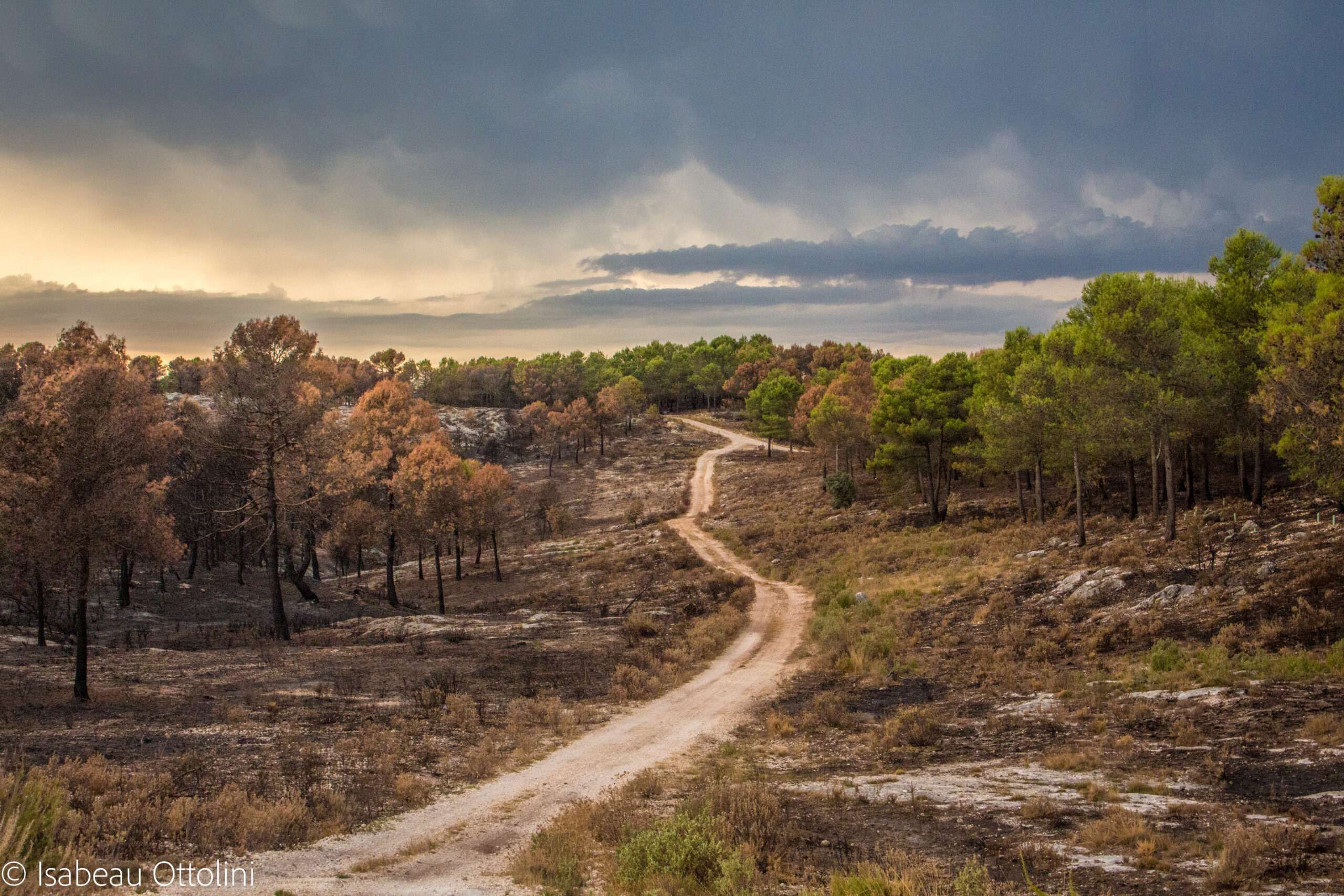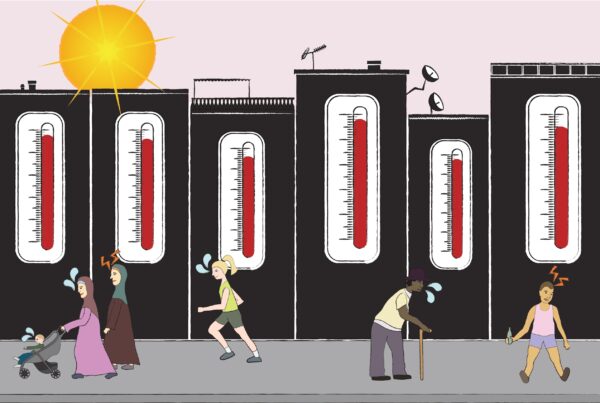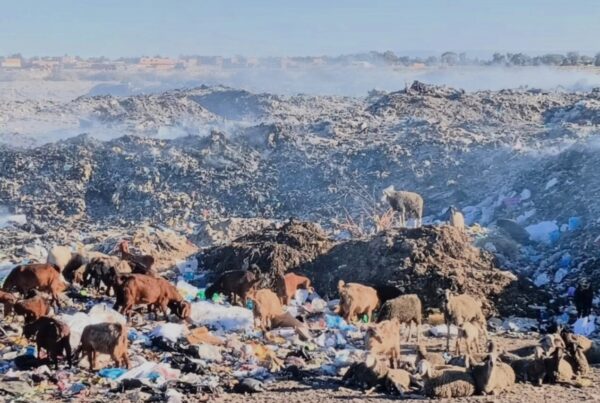By Alexandre Molina Sourdat, Isabeau Ottolini and Kathleen Uyttewaal
While living through and learning about wildfires, we’re also learning more about how to take care of ourselves and others beyond the confines of academia.
Introduction
Wildfire disasters are often important catalysts for reflection and change. In our case, as three social science-oriented wildfire researchers, we recurrently observe and participate in these processes of changes. Recent wildfires in very different parts of the world, such as in Chile, a Hawaiian island, and the south of Spain, have prompted us to sit together and reflect on our personal relationships to these fire events, the limitations of wildfire research, as well as how we as researchers can create more meaningful work in service of others while taking care of ourselves, and maintaining hopeful, grounded engagement beyond our role in academia.
Through this blogpost, we reflect on our personal experiences of living in wildfire-prone territories, critically reflect on current wildfire research paradigms, offer considerations for care-oriented research, and plant some seeds of hope in times of uncertainty and global change. For this, we are guided by a quote from Eduardo Galeano and Fernando Birri: “Utopia is on the horizon. I move two steps closer; it moves two steps further away. I walk another ten steps and the horizon runs ten steps further away. As much as I may walk, I’ll never reach it. So what’s the point of utopia? The point is this: to keep walking.”
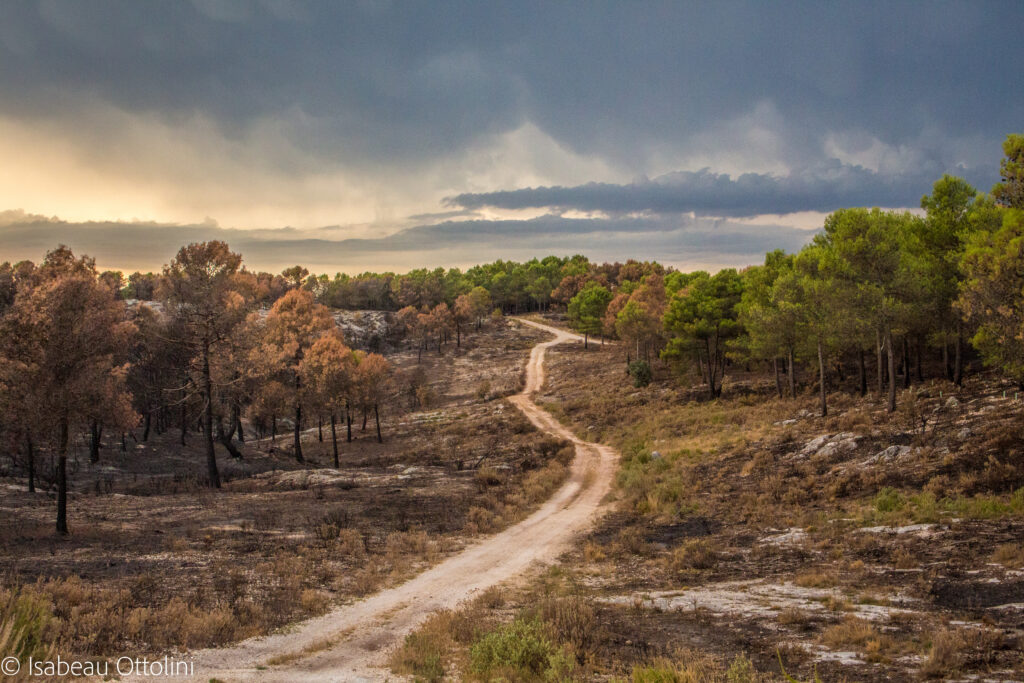
A path winds through a recently burned forest in Vall d’Ebo, Spain. Still, utopia encourages us to walk toward the horizon. Author: Isabeau Ottolini
Converging geographies in flames: from Chile, to Hawai’i, to Spain
What do Chile, a Hawaiian island, and a rural area in Spain have in common? Despite the geographical distance, our personal experiences and reflections create a shared sense of proximity.
This year started with catastrophic news. During the first week of February, a wildfire devastated the Valparaíso Region in central Chile. In just a few days, over 9,000 hectares of rural, agricultural, forested, bush, and urban soil were severely damaged. In the municipalities of Viña del Mar and Valparaíso, nearly 35% of the total surface was affected by the fire. In the human domain, more than 100 lives were lost while thousands of people lost their homes and had to be evacuated and potentially relocated. The severe dry season and high temperatures, in combination with highly informal settlements – which lacked proper evacuation plans and presented high levels of ecological, infrastructural and social vulnerability – catalyzed this disaster. Despite the increase of wildfires in the last decade in Valparaíso and around the country, this catastrophe still caught many local populations and authorities unprepared.
As a Chilean fire researcher recently relocated in Spain, Alexandre is challenged by this distance. Not only as he has been away from his country in these difficult times, but he has witnessed the distance between integrative perspectives on wildfires promoted by Global North academia versus the mainstream discourses heard in Chile. Media narratives in Chile have focused on political and professional negligence and responsibilities, but as social scientists we recognize that broader conclusions must be drawn to mobilize social and political change. In Valparaíso, thousands of dwellings are located in unregulated sectors, exposing a large population not only to critical climate conditions but also to a lack of basic services, evacuation accessibility and minimal infrastructure to combat fire. It is these same marginal material conditions that perpetuated fire risk: light and flammable construction materials were an important factor in the spread of fire in Valparaiso’s periurban contexts. While this problem had already shown in the big fires of 2014 in the same region or 2017 in the Maule region, political action has remained insufficient to properly address wildfire risk, focusing on suppression measures while avoiding real institutional landscape and territorial management.
While wildfire risk is known in places like Chile, let’s consider the town of Lahaina in Maui, Hawai’i. Having lived through wildfires growing up in California, Kathleen feels both a closeness and a distance while working with communities on wildfire issues in Catalonia (Spain). When Lahaina burned in August 2023, she found herself asking through a mixture of grief and anger: how is it that this place experienced the deadliest US wildfire in 100 years ?
Out of innumerable international conferences, oceans of papers, highly detailed models and risk assessments, this area hardly registered on the pulse of current wildfire research. Climate change tells part of the wildfire story in Maui. Meteorological conditions aligned so that a significant drought met hurricane wind conditions and enabled the fire to rip through the landscape. But Hawai’i has battled hundreds of invasive grass species for decades: these fast-growing annuals seed in harsh conditions (including lava rock), offering fodder to fire where vegetation may not have existed before. Earlier, monoculture sugarcane and pineapple production dominated wetland soils. Once these areas were abandoned due to declining soil fertility, the local economy pivoted toward the tourism industry and vegetation growth went unchecked.
Compounding all this, Maui faces a serious housing crisis: locals can no longer afford to live there as real estate prices skyrocket and vacation rentals are reserved for visitors. The familiar linchpin of settler colonialism connects all these hazardous conditions that have accumulated over decades, as the FireGeneration Collaborative asserts. Indigenous populations in Hawai’i were replaced with an invasive settler society that asserts state sovereignty and juridical control. Today, this is embodied by Native Hawaiians’ loss of their rights to steward land and water, and waves of greedy land speculation which have destroyed ecosystems that are not adapted to fire.
Half a world apart, many of the dynamics that led to disaster in Chile and Maui can also be found in the south of Spain, including territorial inequalities materialized through land abandonment in rural regions, housing crises and touristification in urban areas, and an increasingly deeper disconnect between humans and the environment as past ways of relating to, and caring for the land disappear.
Isabeau lives in a territory with many recurrent wildfires, and works as a researcher with citizen initiatives that emerge in response to wildfire events (particularly, Pego Viu). In 2022 she experienced the Vall d’Ebo wildfire close to home and the community she does her research with. As such, Isabeau’s relationship with wildfire is entwined with many, oftentimes contradictory, emotions. For one, she acknowledges the role of fire in the ecosystem she lives in, and she marvels over the incredible adaptability of many non-human beings to wildfires. At the same time, she witnesses and feels a strong sense of loss over transformed landscapes and impacted communities, as well as anticipatory grief and anxiety over future devastating wildfires that are likely to come.
Each of us engages with fire from a complex mixture of emotional, social, and geographical distance or closeness. We recognize both the singularities and commonalities between our research interests, positionalities, and the places and people we care deeply about. As we learn from past experiences, we also see how situations resemble one another and how critical social and material conditions remain largely unaddressed. Our challenge as a new generation of researchers is that we are learning from, engaging with and experiencing climate change and disasters as an everyday embodied matter.
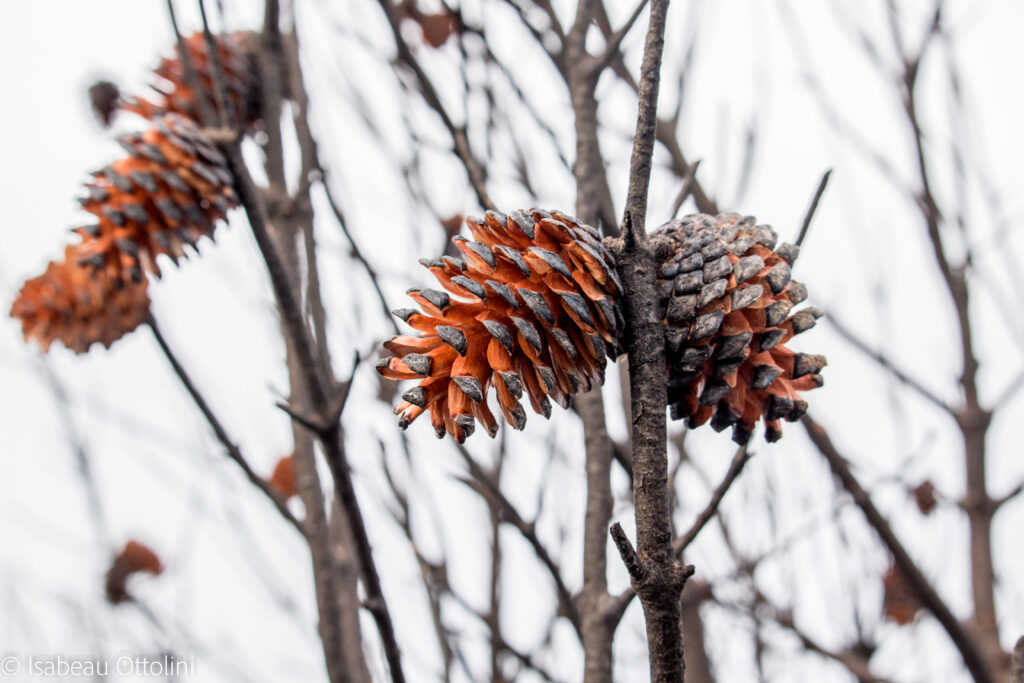
During the wildfire, pinecones started opening to release the seeds and allow a new generation of pines to grow. Author: Isabeau Ottolini.
Critical reflections on wildfire research
A grim paradox about our line of work is that once a tragedy happens, lots of new research will reflect on the conditions leading up to it and the post-disaster effects. Of course, important lessons will be learned and hopefully inform policies and actions to prevent similar events from repeating. Academic and political careers will flourish, hundreds of millions of dollars will pour in for recovery and creativity will blossom. But so many people’s lives have been lost or forever scarred where so much preventative work could have been done around urban planning, sustainable landscape management, and emergency preparedness. Indeed, the multitudes of innovative technologies, illustrious scientific papers, and well-thought policy briefs the world-over did not stop other high-intensity and deadly wildfires from happening like the Camp Fire (USA, 2018), Pedrógão Grande (Portugal, 2017), Mati (Greece, 2018), or the Black Summer fires (Australia, 2019-2020).
More worrying still, some research can exacerbate many unjust dynamics, as it can be based on “extractive, transactional, competitive, and exploitive relationships” between researcher and researched. For instance, wildfire survivors can sometimes experience a flurry of interest from well-meaning scholars who collect stories and relive difficult experiences with them, leading to a feeling of fatigue as they volunteer their time without necessarily receiving results in return from research teams. Furthermore, the wildfire issue is predominantly problematised from an expert perspective: scientists and practitioners seek to rapidly define what the problem is and then provide solutions. But the inhabitants of wildfire-prone territories can rarely obtain the space and time to share their insights, perspectives, and knowledges to build more just ways of coexisting with fire from the bottom up.
The limits are clear: research outputs are too-often driven by funding and power dynamics that tend to primarily benefit research interests (as well as neoliberal, corporate interests seeking product-based results). This is a form of disaster capitalism expressed through research, and it ignores a deeper cry for socioenvironmental justice. As researchers, this can make us feel dread, rage, powerlessness and even numbness in our work. But we must engage with and work through these emotions as we are also people invested deeply in wildfire research in the communities where we live.
Wildfire research continues to be conducted in separate silos of expertise and tends to leave out the most important voices: those of people living in wildfire-prone territories. Often, projects aim to develop partial solutions in disaster prevention, like creating fire breaks, improving fire detection, and firewising homes. However, these solutions are not likely to facilitate the profound socioenvironmental transformations needed to decrease wildfire disasters. For one, wildfires are often merely the visible manifestation of deeper social, political, historical and environmental dynamics. As seen in Chile, Hawai’i and Spain, such dynamics are an entanglement of local, regional and global factors: from rural depopulation, loss of local traditional knowledge and land management practices, and housing crises – all of which increase vulnerabilities to wildfire events, to biodiversity loss and climate change exacerbating extreme wildfire conditions.
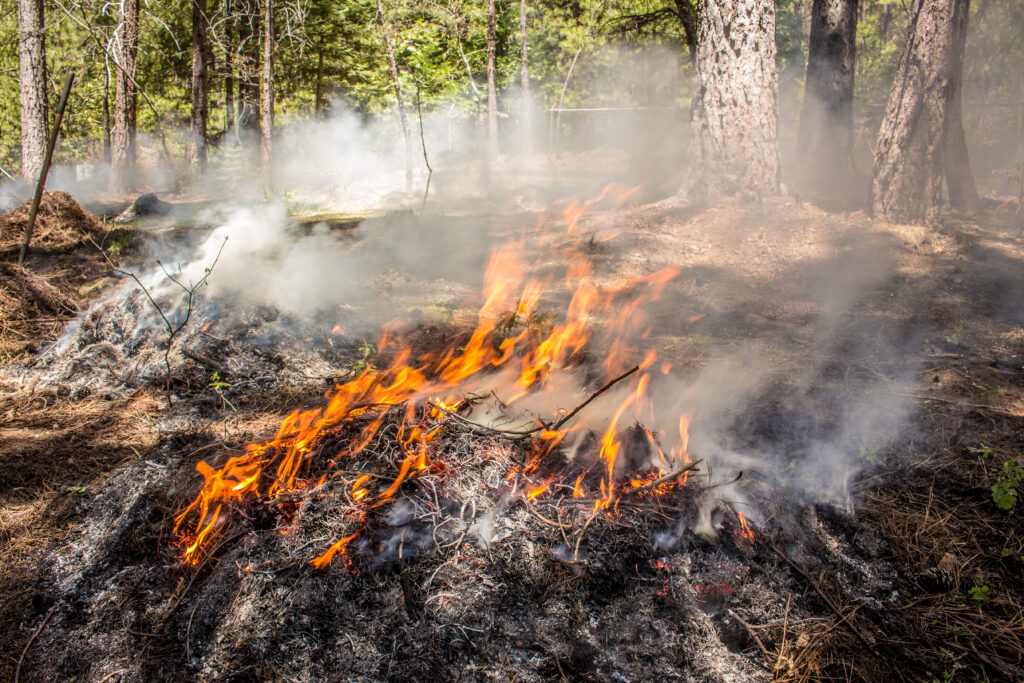
“Restoring our relationship with fire and the land it burns on is not a journey with an end destination- it’s an ongoing process of adaptation to a changing world” – Laurel Kays. Author: Isabeau Ottolini.
Wildfire events will continue to increase in frequency and intensity around the world – in some places already as part of the landscape, and in others as a new element. When the question is not if, but when a disaster will happen, it can feel challenging to not fall into despair, anxiety and fatalism. Not just for the general population, but also those of us who are juxtaposed between inhabiting fire-prone territories, working with local people on wildfire topics, while navigating varied levels of distance and proximity. It is in this space where the ethics of care in disaster research, paired with deliberately cultivating a practice of hope, have inspired us to reach toward a brighter horizon.
Towards more respectful, reciprocal and caring disaster research
So what can we as researchers do to make disaster research more respectful, reciprocal and caring? Many people share this concern, and have done great work to further research based on such principles.
In both disaster research and beyond, incorporating an ethics of care can guide more meaningful engagement. Feminist researchers Ravera, Fernández-Giménez and Oteros highlight the importance of feminist practices, such as reflexivity, embodiment, reciprocity, and care. In practice, this includes reflecting on our own life histories and how these relate to the research we conduct, designing research that engages with bodies, feelings and emotions, and cultivating environments of care and support. These practices foster awareness of the power dynamics in research and give researchers the tools to identify and address asymmetrical or extractive relationships that can occur, for instance, when researching wildfire-affected communities. Another essential practice is taking the time to ask questions and listen to the answers from people who experience the wildfire issue first-hand. Often referred to as a ‘Slow Science’, approach, this allows pluralising our understandings of an issue like wildfires, and informs more holistic and socially beneficial science, rather than seeking to provide quick fixes to a societal problem like wildfires.
To investigate our own priorities, values and relationships when doing disaster research, the Disaster Studies Manifesto and Accord prompts us to ask questions like: “Who researches disaster? What gets researched and why? When the research happens, how it is designed, conducted, shared, and followed up on?”. The FireGeneration Collaborative engages with similar underlying reflections regarding Hawai’i, and invites us all to ask ourselves: “Do we know whose land we are on? Do we know about the settler-colonial history of this place? Do we talk with our friends and communities about these issues? What tribes and Indigenous-led organizations are in the area? And how can we support and resource these efforts?” These reflexive questions provide small steps toward more just disaster studies, and supporting more empowered Indigenous futures.
Importantly, in wildfire disasters an ethics of care is not just for research participants, but also implies a practice of care for ourselves as researchers. Though rarely addressed when talking about research ethics, secondary traumatic stress occurs amongst those doing research with communities affected by disaster. Whilst the source of trauma differs from Posttraumatic Stress Syndrome (by listening to or caring for someone traumatized, vs experiencing it firsthand), the symptoms are similar and can deeply impact the researcher’s life. Speaking from their lived experience in traumatic wildfire research, authors like Eriksen and Ditrich encourage us to “facilitate cultivation of ‘wise attention’ within the research encounter through a deeper awareness, reflection, understanding and acceptance of ever-changing, interdependent processes of life”. Cultivating these kinds of care in academic environments may both help us build resilience in the face of traumatic events and steer us away from extractive and competitive models of research that sacrifice mental health.
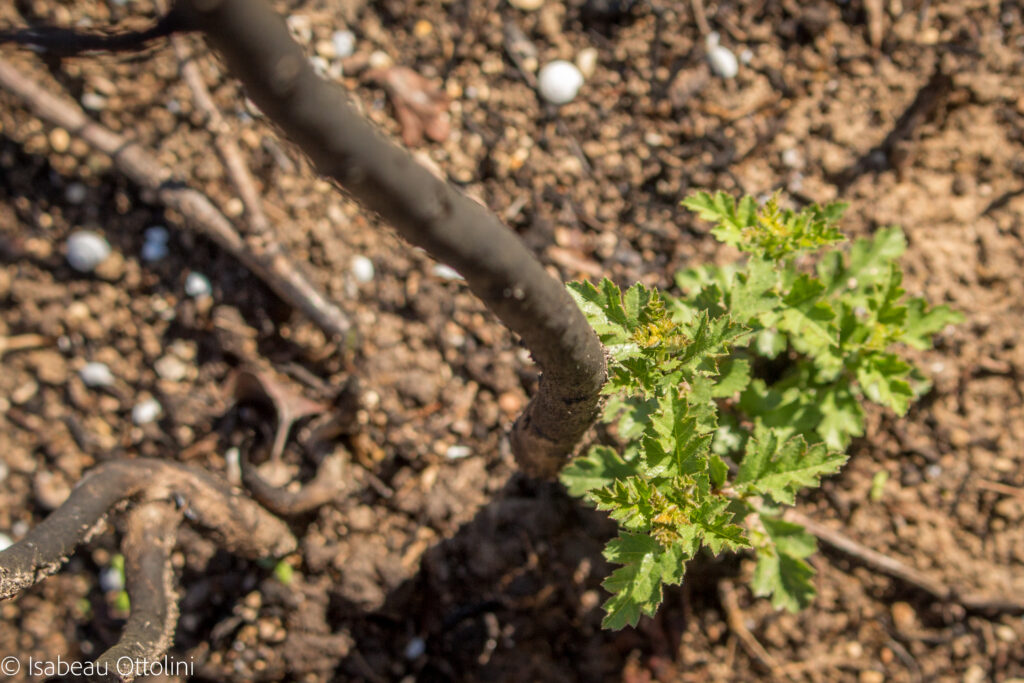
Wild blackberry resprouts weeks after the passing of fire.Robin Wall Kimmerer reminds us that even a wounded world can feed us and give us moments of wonder and joy: “I choose joy over despair.” Author: Isabeau Ottolini.
Closing remarks on the role of hope
“All that these transformations have in common is that they begin in the imagination, in hope. To hope is to gamble. It’s to bet on the future, on your desires, on the possibility that an open heart and uncertainty is better than gloom and safety. To hope is dangerous, and yet it is the opposite of fear, for to live is to risk” (Solnit, 2016).
In wildfire-prone territories, it can be challenging to keep hope alive. Yet, amid this challenge, it is essential to not let it paralyze us into inaction. Instead, we can learn and decide to engage with these complex, confronting and at times heart-wrenching emotions, and decide every day to stand up and contribute our little grain of sand reaching toward a different world. A lot of change is needed, so perhaps we can consider this as an open invitation for our own diverse actions – through research, and especially beyond it.
It is also important to remember that many disasters are being avoided through concerted “symphonies of action,” though they rarely make it to the headlines. Through our research, we have also learned of many inspiring efforts to decrease wildfire risk while providing cascading benefits to various communities. Ramats de Foc in Catalonia revalues traditional rural shepherding livelihoods, reduces wildfire risk, and invigorates sustainable local food systems. And trainings like WTREX (hosted in USA, South Africa and Portugal) amplify the role of women and their allies in integrated fire management. Such trainings increase global capacities for prescribed fire while uplifting Indigenous and traditional ecological knowledge. These local and global efforts remind us of authors and thinkers like Mariame Kaba, and Howard Zinn, who urge us to see that hope is a practice rather than a feeling.
“And if we do act, in however small a way, we don’t have to wait for some grand utopian future. The future is an infinite succession of presents, and to live now as we think human beings should live, in defiance of all that is bad around us, is itself a marvelous victory” (The Optimism of Uncertainty, 2004).
By recognizing and engaging with our struggles (both through our research and shared humanity), though we may not see the fruits of our labor in our lifetimes, we choose to create a better world. We, too, will grow and change thanks to taking action over the course of our lifetimes. Jenny Odell encourages us to stay open, relational, listening and learning and willing to change ourselves. Although this can make us more vulnerable to grief – for we acknowledge that we have something to lose and we risk losing what we love – it also means that we are alive, changing, and form part of a larger collective navigating the wide spectrum of emotions that fire generates, including grief and love.
What keeps our hope alive even in the darkest times is our connections to this longer story of human and planetary history, and the knowledge that we must cherish and rise for what we love and hold dear. Darkness, then, is also a place of action, as Solnit also says: “The future is dark, with a darkness as much of the womb as the grave.”
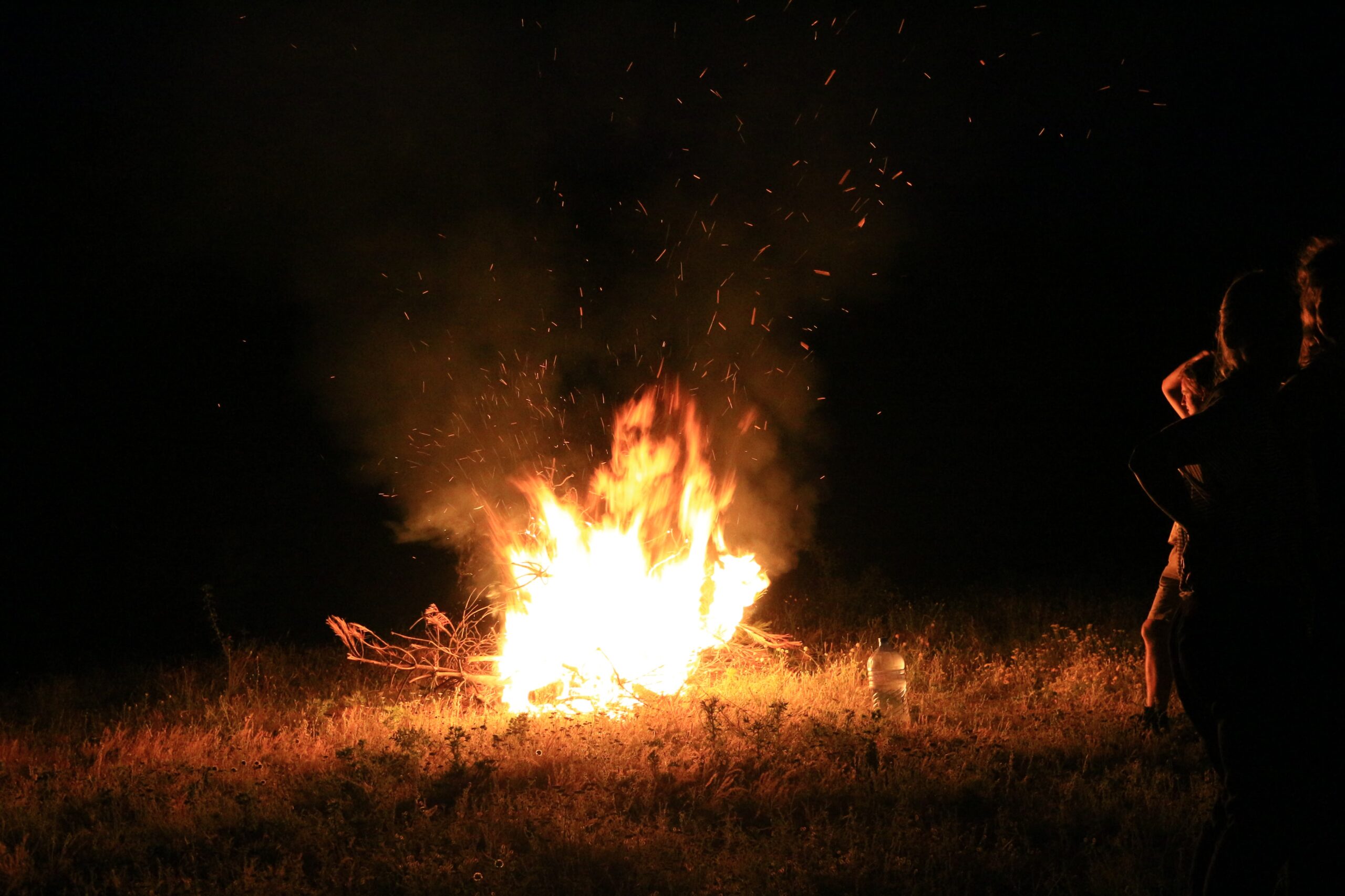
Gathering around the fire, we jointly reflect on kindling hope and forming part of meaningful change. Author: Isabeau Ottolini.
Alexandre Molina Sourdat is an Early Stage Researcher at the Open University of Catalunya (Spain). After studying and researching in Chile, his present interests focus around suburban wildfire risk and methodologies for community engagement in different geographical contexts.
Isabeau Ottolini is a PhD candidate at the Open University of Catalonia (Spain) and the European project PyroLife. Her research focuses on community-led wildfire communication, which she explores in collaboration with Pego Viu, a citizen initiative born from the ashes of the Vall d’Ebo wildfire in 2015.
Kathleen Uyttewaal is a PhD candidate at Wageningen University (Netherlands) through the European project PyroLife. Her research is primarily based in Catalonia, developing transdisciplinary approaches to wildfire issues with the Pau Costa Foundation. Born in France, raised in California, and living in Catalonia, her passion for Mediterranean ecosystems, their people, cultures and languages runs deep.


